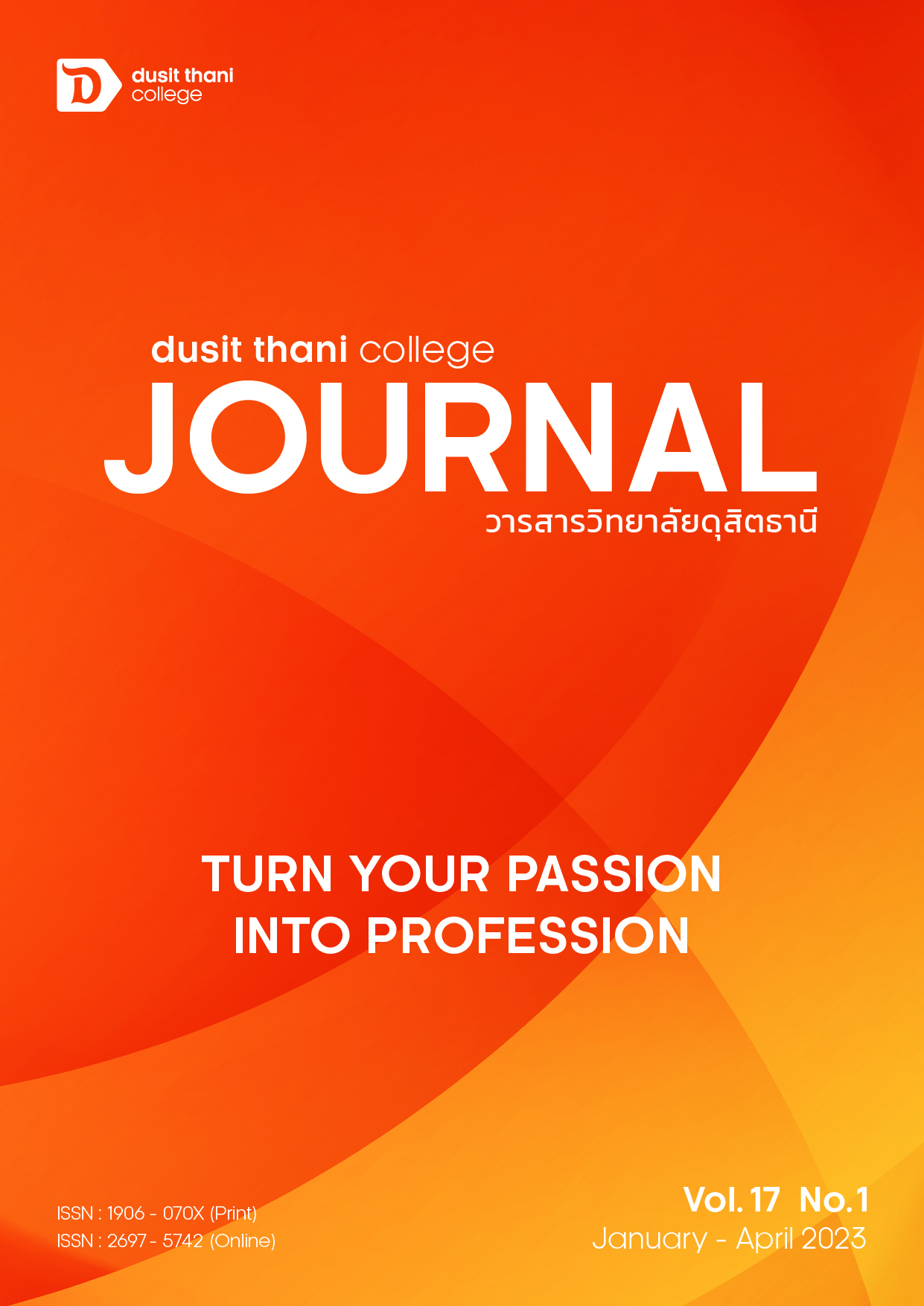การวิเคราะห์องค์ประกอบหลักและการจัดกลุ่มปัจจัยส่วนประสมทางการตลาดต่อการตัดสินใจเลือกเข้าศึกษาต่อที่วิทยาลัยเทคโนโลยีสารสาสน์
Main Article Content
บทคัดย่อ
การวิจัยนี้มีวัตถุประสงค์เพื่อวิเคราะห์ปัจจัยหลักและจัดกลุ่มพฤติกรรมของนักเรียนในระดับอาชีวศึกษา เกี่ยวกับการตัดสินใจเลือกเข้าศึกษาต่อที่วิทยาลัยเทคโนโลยีสารสาสน์ ประชากรในการวิจัย คือ นักเรียนที่กำลังศึกษาชั้นประกาศนียบัตรวิชาชีพ (ปวช.) ปีที่ 1 จำนวน 230 คน การวิเคราะห์ปัจจัยส่วนประสมทางการตลาดซึ่งมีทั้งหมด 7 ด้าน ได้ใช้วิธีการวิเคราะห์องค์ประกอบหลักและหมุนแกนปัจจัยด้วยวิธี Varimax เพื่อสกัดองค์ประกอบหลักที่มีค่า Eigenvalues มากกว่า 0.5 จากนั้นนำมาจัดกลุ่มโดยใช้วิธีการจัดกลุ่มแบบ K-Means ซึ่งพบว่า พฤติกรรมการตัดสินใจเลือกเข้าศึกษาต่อจะถูกพิจารณาจากสาขาที่ต้องตรงต่อความต้องการเป็นหลัก นอกจากนี้ ค่าใช้จ่ายในการศึกษายังเป็นองค์ประกอบสำคัญในการพิจารณา เนื่องจากครอบครัวของนักศึกษาส่วนใหญ่มีฐานะปานกลาง ทั้งนี้องค์ประกอบหลักของการตัดสินใจเลือกเข้าศึกษาต่อสามารถสกัดได้ทั้งสิ้น 4 ด้าน คือ ด้านการบริการ (Eigenvalues = 4.418 และร้อยละความแปรปรวน = 63.121) ด้านช่องทางการจัดจำหน่าย (Eigenvalues = 0.783 และร้อยละความแปรปรวน = 11.193) ด้านค่าใช้จ่ายในการศึกษา (Eigenvalues = 0.563 และร้อยละความแปรปรวน = 8.047) และด้านการส่งเสริมการตลาด (Eigenvalues = 0.479 และร้อยละความแปรปรวน = 6.846) ส่วนผลการจัดกลุ่มองค์ประกอบหลักที่สกัดได้สามารถจำแนกออกเป็น 2 กลุ่ม คือ กลุ่มที่ให้ความสำคัญกับความคุ้มค่าของราคา (ร้อยละ 18.27) และกลุ่มที่ให้ความสำคัญกับการสื่อสารการตลาด (ร้อยละ 81.73) ดังนั้น วิทยาลัยเทคโนโลยีสารสาสน์จำเป็นต้องเน้นกลยุทธ์การสื่อสารการตลาดและความคุ้มค่าของราคาเป็นหลัก
Article Details

อนุญาตภายใต้เงื่อนไข Creative Commons Attribution-NonCommercial-NoDerivatives 4.0 International License.
นโยบายการพิจารณากลั่นกรองบทความ
- บทความวิจัยและบทความวิชาการทุกเรื่องที่จะได้รับการตีพิมพ์ต้องผ่านการพิจารณากลั่นกรองโดยผู้ทรงคุณวุฒิ (Peer Review) ในสาขาที่เกี่ยวข้อง จำนวน 3 ท่าน/บทความ
- บทความ ข้อความ ภาพประกอบและตารางประกอบที่ลงตีพิมพ์ในวารสารเป็นความคิดเห็นส่วนตัวของผู้เขียน กองบรรณาธิการไม่จำเป็นต้องเห็นด้วยเสมอไป และไม่มีส่วนรับผิดชอบใด ๆ ถือเป็นความรับผิดชอบของผู้เขียนแต่เพียงผู้เดียว
- บทความที่จะได้รับการตีพิมพ์จะต้องไม่เคยตีพิมพ์ เผยแพร่ที่ใดมาก่อน และไม่อยู่ระหว่างการพิจารณาของวารสารฉบับอื่น หากตรวจสอบพบว่ามีการตีพิมพ์ซ้ำซ้อน ถือเป็นความรับผิดชอบของผู้เขียนแต่เพียงผู้เดียว
- บทความใดที่ผู้อ่านเห็นว่าได้มีการลอกเลียนหรือแอบอ้างโดยปราศจากการอ้างอิง หรือทำให้เข้าใจผิดว่าเป็นผลงานของผู้เขียน กรุณาแจ้งให้กองบรรณาธิการวารสารทราบจะเป็นพระคุณยิ่ง
เอกสารอ้างอิง
Anansetthakan, P., & Mahaprom, S. (2022). “Marketing Mix that Affects Skincare’s Buying Behaviors via Social Media (Instagram) of Generation Y in Kanchanaburi Province”. Journal of Management Science, Nakhon Pathom Rajabhat University, 9(1), 413-428.
Arifin, Z. L., Sumarwan, U., & Najib, M. (2020). The Influence of Marketing Mix on Brand Image, Motivation and Students Decision to Choose Graduate Studies of IPB University. Journal of Consumer Sciences, 139-156.
Baohinlad, S., & Chankuna, D. (2022). “Marketing Mix Factors Affecting Customer’s Decision Making in Purchasing Sports Equipment”. MUT Journal of Business Administration, 19(1), 65-82.
Booms, B. H., & Bitner, M. J. (1981). Marketing Strategies and Organizational Structures for Service Firms: Marketing of Services. Chicago: American Marketing Association.
Etzel, M. J., Walker, B. J., & Stanton, W. J. (2007). Marketing, 14 ed. Boston: McGraw-Hill.
Johnston, R. (2004). Towards a Better Understanding of Service Excellence. Journal of Service Theory and Practice, 129-133.
Keller, K. L., & Kotler, P. (2012). Marketing Management 13th Edition, Edinburgh Gate. London: Pearson Education.
Khruachalee, K. (2020). Analysis of Principal Component and Clustering of Decision-Making Behavior to Use Service of Kerry Express Company Limited in Bangkok, Burapha Journal of Business Management, 9(1), 1-18.
Kukar-Kinney, M., Ridgway, N. M., & Monroe, K. B. (2012). The Role of Price in the Behavior and Purchase Decisions of Compulsive Buyers. Journal of Retailing, 88(1), 63-71.
Kumar, N., & Steenkamp, J. B. E. (2009). Private label strategy: How to Meet the Store Brand Challenge. Boston, MA: Harvard Business School Press.
Nakamatsu, M., Panluekdet, T., & Laosri, C. (2022). Consumer Behavior and Integrated Marketing Communications Influencing App Purchase Decisions: A Comparative Case Study Between Shopee and Lazada. Southeast Asian University Journal of Humanities and Social Sciences, 6(2), 17. -32.
Office of the Vocational Education Commission. (5 February 2021). Size of public and private colleges. Accessed from vec.co.th: www.vec.co.th/th-th/homepage.aspx
Perreault, W. D., McCarthy, E., & Cannon, J. P. (2011). Basic Marketing: A Global-Managerial Approach, 18th ed. Boston: McGraw-Hill.
Prasit Narapan, K., & Sakulkitkan, W. (2019). Image of the University Perception of Teaching Quality and Marketing Communication Related to the Decision to Study for a Master's Degree at Srinakharinwirot University, Journal of Social Sciences, 11(1), 26-36.
Thiel, P., & Masters, B. (2014). Zero to One: Notes on Startups, or How to Build the Future. New York: Crown Business.


